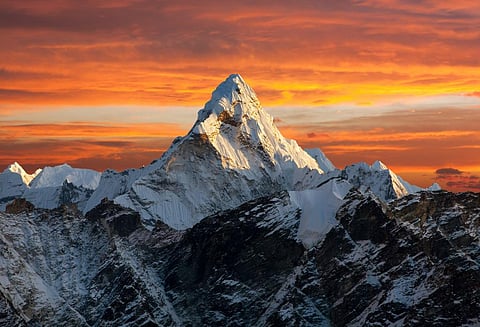

Seven decades after Edmund Hillary and Tenzing Norgay first scaled Mount Everest, the Earth’s tallest mountain is undergoing unprecedented and largely irreversible change caused by global warming, warned an intergovernmental institution working towards safeguarding the Hindu Kush Himalaya (HRH).
Human activity has pushed Earth’s systems close to tipping points beyond which sustaining life will be extremely challenging, said a press briefing by International Centre for Integrated Mountain Development (ICIMOD), based in Nepal.
Global temperature rises are jeopardising the environment of Everest and the Hindu Kush Himalaya (HKH) region, which extends 3,500 km across eight countries. Mountain communities, climbers and scientists urged world leaders for immediate global action to address climate change.
In the next 70 years, scientists project that two-thirds of glaciers in the region will disappear under the current emissions scenario, ICIMOD further stated.
A declaration by ICIMOD called on governments to honour their commitments under the 2015 Paris Agreement, make rapid and deep emission cuts, end all new coal, oil and gas exploration and accelerate the transition to renewable energy.
ICIMOD, supported by mountain institutes globally — including Nepal Mountaineering Association and the Mountain Partnership (the United Nations voluntary alliance of partners)— also asked for public support back the #SaveOurSnow campaign.
The campaign declaration has 1,500 signatories, including Rt Hon Helen Clark, former Prime Minister of New Zealand; Jamling and Norbu Tenzing, Tenzing Norgay’s sons and Peter and Lily Hillary, son and granddaughter of Edmund Hillary, respectively.
The campaign asked the public to:
The 79 glaciers surrounding Everest have thinned by over 100 metres in just six decades and the thinning rate has nearly doubled since 2009, ICIMOD further said. Among those is the iconic Khumbu glacier, the starting place for most expeditions, including Hillary and Tenzing Norgay’s all those decades ago, which scientists say is just degrees away from some vanishing and some shrinking.
Studies have warned that extreme weather events like heatwaves, droughts, maximum one-day rainfall and extreme wind events will likely become a near-permanent in some 20 countries, even if the world curtails warming to 1.5 degrees Celsius.
Each of the years between 2023 and 2027 would be warmer than the pre-industrial average (1850-1900) by 1.1-1.8 degrees Celsius, research has further warned. One of these years has a 66 per cent chance of crossing the annual average temperature of 1.5°C.
The HKH region is seeing an increase in adverse impacts from climate change, which will only increase in intensity and frequency, the ICIMOD press note added.
“The dangerous impacts of global warming are already being felt throughout the Hindu Kush Himalaya in record-breaking heat waves, droughts, natural disasters, unpredictable snowfall and precipitous and largely irreversible glacial melt,” Pema Gyamtsho, ICIMOD director general, said in the press note.
We need urgent global action to protect the lives and livelihoods of the people in this region and to safeguard the countless, irreplaceable lifeforms that exist only here, Gyamtsho added.
The HKH is home to 240 million people, and nearly a quarter of the world’s population depends on the water that flows from its mountains. The fight against climate change is, therefore, critically important and requires urgent global action.
In January 2023, innovator and environmentalist Sonam Wangchuk went on a ‘climate strike’, urging the Prime Minister to intervene to protect Ladakh. Climate impact is visible in the Himalayas, with 25 glacial lakes and water bodies witnessing an increase in water spread area since 2009, he said.
There has been a 40 per cent increase in water spread area in India, China and Nepal, posing a huge threat to seven Indian states and Union Territories, according to Delhi-based Centre for Science and Environment and Down To Earth’s report, State of India’s Environment 2022: In Figures.